.

The homebound Expedition 40/41 trio, consisting of Soyuz Commander Max Suraev and Flight Engineers Alexander Gerst and Reid Wiseman, is counting down to its Nov. 9 departure inside the Soyuz TMA-13M spacecraft. They are packing gear to be returned home while they continue science and maintenance on the U.S. side of the International Space Station.
Quelle: NASA
.
Russian Soyuz to Return From Space on November 10
The spacecraft Soyuz is due to return to Earth from its mission to the International Space Station (ISS) on November 10, Colonel Yaroslav Roshupkin, Assistant Commander for the Central Military District of Russia, told journalists on Friday.
“The touchdown of the spacecraft is planned for November 10, at 6:57 MSK, in an area close to the Kazakh town of Arkalyk,” said Roshupkin.
Roshupkin added that a group of military experts trained in emergency services from the Central Military District had already gathered in Kazakhstan, preparing for the landing and any eventualities. Around 300 servicemen, 14 Mi-8 helicopters, two An-26 planes and six search and rescue machines have been deployed in the landing effort.
The ship’s crew comprises commander Maksim Suraev of the Russian Space Agency, NASA astronaut Reid Wiseman and European Space Agency astronaut Alexander Gerst. The three have been in orbit since May 28 this year, and have also been sharing their spacecraft with a sample of fruit flies. The flies found themselves in space as part of an investigation into the effect of weightlessness on the development of multicellular organisms.
At the pre-launch press conference in Baikonur, Kazakhstan, a journalist put the question of political tension between their respective countries to the astronauts. “Is there any place for politics in space,” they were asked. The international crew demonstrated their togetherness by standing up and heartily embracing each other. “That’s our answer,” they replied.
Also at the conference the team became the first in history to take a selfie before their launch, which they posted to Twitter. Suraev previously made the history books as the first cosmic blogger, when during his first flight in space he kept a diary which was published on the Russian Space Agency website. While on the current mission he has regularly made updates to his Twitter account and posted photos from space.
Quelle: RIA NOVOSTI
.
Update: 23.30 MEZ
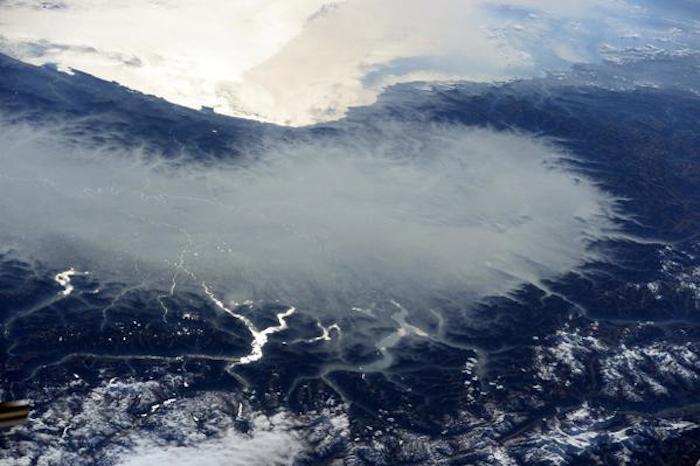
Northern #Italy weather update. Fog or smog? #BlueDot
.

Letzte Blicke auf unsere Erde...

To realize how fragile our little blue planet is, I needed only a single glance. #BlueDot
Quelle: ESA
.
Update: 9.11.2014
.

The prime crew members for International Space Station Expedition 40 take a break in training for a crew portrait on Aug. 22, 2013. From the left are Flight Engineer Alexander Gerst of the European Space Agency, Soyuz Commander Maxim Suraev of Russia's Federal Space Agency (Roscosmos) and Flight Engineer Reid Wiseman of NASA.
Image Credit: Gagarin Cosmonaut Training Center
.
Three of the crew members aboard the International Space Station are scheduled to depart the orbiting laboratory Sunday, Nov. 9 after almost six months aboard. NASA Television will provide complete coverage.
Expedition 41 Commander Max Suraev of the Russian Federal Space Agency (Roscosmos), NASA Flight Engineer Reid Wiseman and Flight Engineer Alexander Gerst of the European Space Agency (ESA) will undock their Soyuz spacecraft from the station at 7:30 p.m. EST for a landing in Kazakhstan at 10:58 p.m. (9:58 a.m. Nov. 10 Kazakh time). Their return will wrap up 165 days in space since launching from Kazakhstan on May 29 and a mission that covered almost 70 million miles in orbit.
With their landing, Suraev will have spent 334 days in space on two flights, and Wiseman and Gerst will have logged 165 days in space on their first flights.
At the time of undocking, Expedition 42 will formally begin aboard the station under the command of NASA astronaut Barry Wilmore. Along with his crewmates Alexander Samokutyaev and Elena Serova of Roscosmos, Wilmore will operate the station as a three-person crew for two weeks until the arrival of three new crew members. NASA astronaut Terry Virts, Russian cosmonaut Anton Shkaplerov and ESA astronaut Samantha Cristoforetti are scheduled to launch from Baikonur, Kazakhstan, Nov. 23, (U.S. time).
NASA Television coverage includes:
Sunday, Nov. 9:
-- 3:45 p.m. - Farewell and hatch closure coverage. Includes replay of Nov. 8 change of command ceremony in which Suraev hands over station command to Wilmore; hatch closure at 4:10 p.m.
-- 7:15 p.m. - Undocking coverage. Undocking at 7:30 p.m.
-- 9:45 p.m. - Deorbit burn and landing coverage. Deorbit burn at 10:05 p.m., with landing at 10:58 p.m.
Monday, Nov. 10
-- 1 a.m. - Video File of hatch closure, undocking and landing activities
-- Noon - Video File of landing and post-landing activities and post-landing interviews with Reid Wiseman and Alexander Gerst in Kazakhstan
Quelle: NASA
.
Update: 10.11.2014
.
Expedition 41 Lands Safely in Kazakhstan
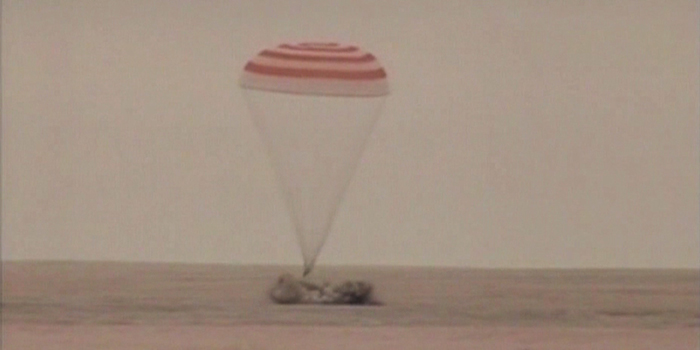
The Soyuz TMA-13M carrying the Expedition 41 trio fires its soft-landing engines right on time at 10:58 p.m. EST.
Expedition 41 Flight Engineers Reid Wiseman of NASA, Alexander Gerst of the European Space Agency and Commander Maxim Suraev of the Russian Federal Space Agency (Roscosmos) landed their Soyuz TMA-13M spacecraft in Kazakhstan at 10:58 p.m. EST. The trio arrived at the International Space Station on May 29, and spent more than five months conducting research and maintenance activites.
Russian recovery teams will help the crew exit the Soyuz vehicle and adjust to gravity after their stay in space. Wiseman, Gerst and Suraev spent 165 days aboard the space station and clocked more than 70 million miles during their time in space.
This was the first mission for both Wiseman and Gerst. Suraev now has spent 334 days in space during two missions, including Expeditions 21 and 22.
The station now is occupied by Expedition 42 Commander Barry “Butch” Wilmore of NASA and Flight Engineers Alexander Samokutyaev and Elena Serova of Roscosmos. They will remain aboard the station to continue research and maintenance until the remainder of the Expedition 42 crew arrives later this month. NASA astronaut Terry Virts, Russian cosmonaut Anton Shkaplerov and ESA astronaut Samantha Cristoforetti are scheduled to launch from Baikonur, Kazakhstan, Nov. 23, (U.S. time).
.

Screens at the Mission Control Center in Russia signify a safe landing for the Expedition 41 trio inside the Soyuz TMA-13M spacecraft. Credit: NASA TV

Quelle: NASA
.
Update: 22.00 MEZ
.
Rückkehr von ISS / Frams: NASA-TV
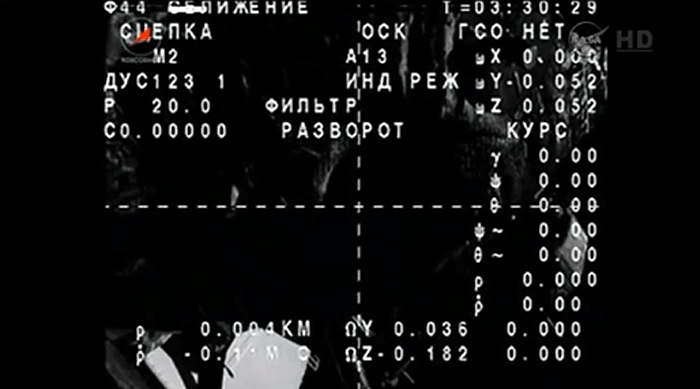




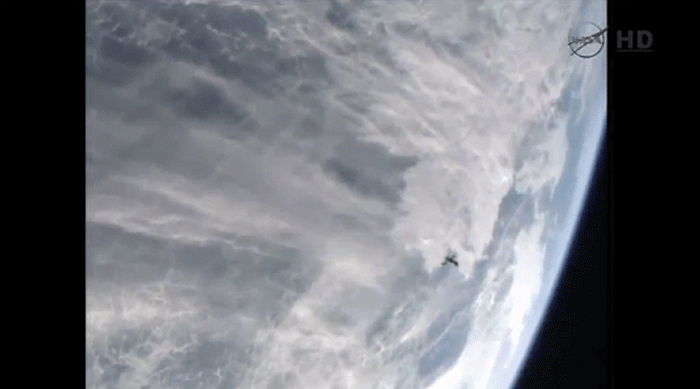

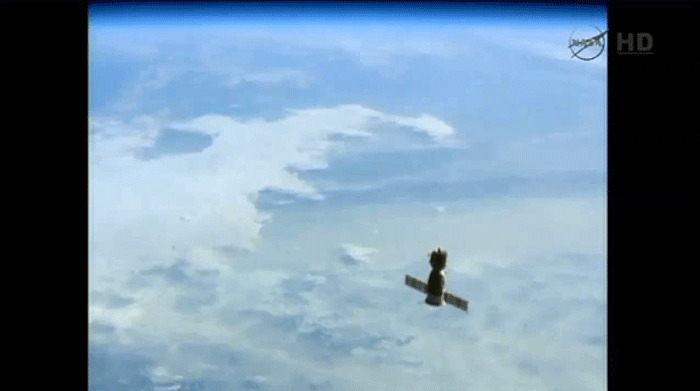

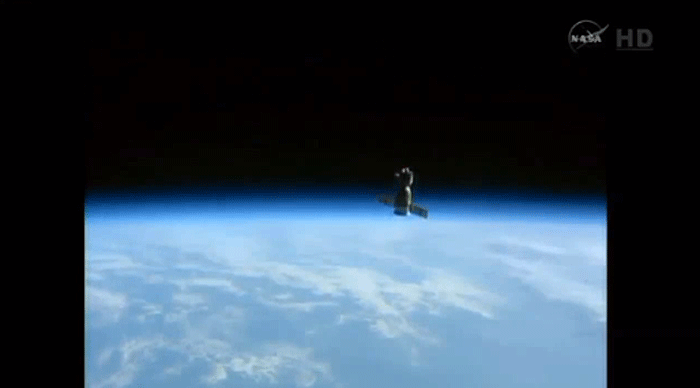


...
Space Station Crew Returns to Earth, Lands Safely in Kazakhstan
.

European Space Agency astronaut Alexander Gerst (left), Russian cosmonaut Maxim Suraev (center) and NASA astronaut Reid Wiseman pose for a portrait in the Harmony node of the International Space Station. The three crew members of Expedition 41 returned to Earth at 10:58 p.m. EDT Sunday, Nov. 9.
Image Credit: NASA
.
Three International Space Station (ISS) crew members returned to Earth Sunday after a 165-day mission that included hundreds of scientific experiments and several spacewalks.
Expedition 41 Commander Max Suraev of the Russian Federal Space Agency (Roscosmos) and Flight Engineers Reid Wiseman of NASA and Alexander Gerst of the European Space Agency touched down northeast of the remote town of Arkalyk in Kazakhstan at 10:58 p.m. EST (9:58 a.m., Nov. 10, Kazakh time). While in space, they traveled more than 70 million miles.
During their time aboard the station, the crew participated in research focusing on Earth remote sensing, advanced manufacturing, and studies of bone and muscle physiology. They set a milestone for station science by completing a record 82 hours of research in a single week in July.
A key research focus during Expedition 41 was human health management for long duration space travel, as NASA and Roscosmos prepare for two crew members to spend one year aboard the space station beginning in 2015.
The crew welcomed five cargo spacecraft during its time aboard the orbiting laboratory. Two Russian ISS Progress cargo vehicles docked to the station, bringing tons of supplies in July and October. The fifth and final European Automated Transfer Vehicle, dubbed the Georges Lemaitre after the Belgian physicist who is considered the father of the big-bang theory, launched to the station in July.
In July, Orbital Sciences' Cygnus spacecraft completed its second resupply mission under NASA's Commercial Resupply Services contract. SpaceX launched its Dragon spacecraft to the station in September, the company's fourth commercial resupply mission.
Wiseman and Gerst ventured outside the confines of the space station for a planned spacewalk to relocate a failed pump module and configure the station for upcoming additions. Wiseman completed a second spacewalk with fellow NASA astronaut Barry Wilmore. Suraev also conducted one spacewalk during Expedition 41.
In addition to being a scientific research platform, the space station also serves as a test bed to demonstrate new technology. The first 3-D printer to be tested in space arrived at the station during Expedition 41. It will be the first step toward establishing an on-demand machine shop in space, which is a critical enabling component for deep space crewed missions and in-space manufacturing.
A new Earth monitoring instrument called RapidScat also was installed and activated on the station during the crew’s time in orbit. RapidScat will measure Earth's ocean surface wind speed and direction, essential measurements used in weather prediction.
Having completed his second space station mission, Suraev now has spent 334 days in space. Wiseman and Gerst have spent 165 days in space with the end of their first flights.
Expedition 42 now is operating aboard the station with Barry Wilmore of NASA in command. Wilmore and his crewmates, Flight Engineers Alexander Samokutyaev and Elena Serova of Roscosmos, will tend to the station as a three-person crew until the arrival in two weeks of three new crew members: Terry Virts of NASA, Anton Shkaplerov of Roscosmos and Samantha Cristoforetti of the European Space Agency. Virts, Shkaplerov and Cristoforetti are scheduled to launch from Kazakhstan on Nov. 23 (U.S. time).
Quelle: NASA
.

Soyuz TMA-13M crew patch. (Roscosmos/spacepatches.nl)






Astronaut Reid Wiseman smiles and chats with support crews shortly after returning to Earth aboard a Russian Soyuz spacecraft late Sunday U.S. time along with commander Maxim Suraev and German astronaut Alexander Gerst. Landing marked the end of a 165-day stay aboard the International Space Station. (Credit: NASA TV)


Quelle: roscosmos
.
Welcome back, Alex! - Deutscher ESA-Astronaut zurück auf der Erde

Alexander Gerst bei seiner Ankunft in Köln am 10.November 2014
.
Der deutsche ESA-Astronaut Alexander Gerst ist nach fünfeinhalb Monaten im All wieder zurück auf der Erde: der 38 Jahre alte Geophysiker und Flugingenieur landete am 10. November 2014 nach dreieinhalb Stunden Flugzeit an Bord eines russischen Sojus-Raumschiffs um 4.58 Uhr Mitteleuropäischer Zeit (9.58 Uhr Ortszeit) in der kasachischen Steppe, rund 100 Kilometer von der Stadt Arkalik entfernt. Alexander Gerst flog mit seinen beiden Crew-Kollegen der ISS Expeditionen 40 und 41, dem Kosmonauten Maxim Surajew und dem NASA-Astronauten Reid Wiseman. Das Trio war am 28. Mai 2014 ebenfalls an Bord eines Sojus-Raumschiffs vom russischen Weltraumbahnhof in Baikonur in Kasachstan aus zur Internationalen Raumstation gestartet. Gerst ist der erste deutsche Astronaut, der nach seinem Raumflug unmittelbar nach Deutschland zurückkehren und sich im :envihab des Deutschen Zentrums für Luft- und Raumfahrt (DLR), einer der weltweit modernsten Luft- und Raumfahrtmedizinischen Forschungseinrichtungen, untersuchen lassen wird.
"Mit der sicheren Landung der Sojus-Kapsel hat die Blue Dot- Mission von Alexander Gerst ein erfolgreiches Ende gefunden. Mission erfüllt!", sagte Prof. Dr.-Ing. Johann-Dietrich Wörner, Vorstandsvorsitzender des DLR. "Ich freue mich besonders über die rund 100 Experimente, an denen Alex Gerst beteiligt war, 25 Versuche allein aus Deutschland. Mit seinem Flug hat sich gezeigt, dass Deutschland in der astronautischen Raumfahrt, insbesondere deren Nutzung, eine weltweit führende Rolle spielt", betonte Wörner.
Von einem "Mammutprogramm", das der promovierte Vulkanologe in 165 Tagen auf der ISS absolviert habe, spricht auch Volker Schmid, DLR-Manager für die Blue Dot-Mission von Alexander Gerst. "Die wissenschaftlichen Disziplinen reichten von Fluidphysik, Materialwissenschaften, Humanphysiologie über Strahlenbiologie und Astrophysik bis hin zu Robotik und Technologiedemonstrationen. Auch zwei industrielle Experimente waren dabei, die erfolgreich abgeschlossen bzw. begonnen wurden." Ein Highlight seiner Mission war sein mehr als sechsstündiger Außenbordeinsatz (Extra Vehicular Activity, EVA) am 7. Oktober 2014, bei dem er zusammen mit Reid Wiseman wichtige Wartungsarbeiten an der ISS erledigte.
Wissenschaft und Wartung
Alexander Gerst startete am 28. Mai 2014 vom Weltraumbahnhof in Baikonur mit einer Sojus TM-A 13 (39S). Gut sechs Stunden später dockte das Raumschiff am ISS-Modul "Rassvet" am russischen Teil der Raumstation an. Gerst war seit 2008 der erste Deutsche im All und der zweite, der nach Thomas Reiter (2006) einen Langzeitaufenthalt von fast einem halben Jahr auf der ISS absolviert hat. Neben der alltäglichen wissenschaftlichen Arbeit hat der jüngste und insgesamt elfte deutsche Astronaut Wartungsarbeiten erledigt und Versorgungsfahrzeuge in Empfang genommen; darunter den letzten europäischen Frachter ATV-5 "Georges Lemaitre", der am 12. August 2014 an der ISS andockte. ATV-5 hatte unter anderem die deutschen Experimente EML, MagVector, WiseNet und SpaceTex an Bord, die Gerst ausgepackt und im europäischen Forschungslabor Columbus installiert hat.
"Gerst war auch trainiert für die Ankunft der US-Versorgungsraumschiffe ‚Dragon‘ und ‚Cygnus‘, von denen er während seiner Mission jeweils eines mithilfe des Manipulatorarms an die Station ankoppelte", berichtet DLR-Missionsmanager Volker Schmid. Darüber hinaus hat Alexander Gerst Menschen weltweit mit seinen persönlichen Eindrücken, Fotos und Videos aus dem All fasziniert, die er regelmäßig in den sozialen Medien geteilt hat. Auch so genannte "Live-Calls" - ein Telefonat aus dem All - gehörten zu den Aufgaben. So sprach Alex Gerst am 4. September 2014 mit rund 5000 begeisterten Zuhörern in seiner baden-württembergischen Heimatstadt Künzelsau.
Täglicher Austausch mit dem Columbus-Kontrollzentrum
Für einen reibungslosen Ablauf der Arbeiten auf der ISS ist eine ständige Verbindung zwischen den Astronauten und den Teams in den Bodenstationen entscheidend: Die zentrale „Heimat“-Bodenstation für Alexander Gert war das Columbus-Kontrollzentrum beim DLR in Oberpfaffenhofen. „"Wir haben mit weit über 30.000 Arbeitsstunden Alex‘ Mission unterstützt. Nicht nur während der Mission an den permanent besetzten Konsolen im Kontrollraum, sondern auch in der monatelangen Vorbereitung und über die verschiedenen Koordinierungsaufgaben hinter den Kulissen", erklärt Columbus-Flugdirektor Thomas Uhlig. "Die Blue-Dot-Mission hat großes öffentliches Interesse ausgelöst. Bei unserem Tag der Offenen Tür am 12. Oktober 2014 war das Deutsche Raumfahrtkontrollzentrum kontinuierlich von Menschenmassen belagert“, schildert Uhlig und ergänzt: "In den vergangenen Jahren konnte die Zeit, die die Astronauten mit wissenschaftlichen Experimenten verbringen, deutlich erhöht werden. Alexander Gerst und seine Kollegen halten mit 80 Stunden Wissenschaft in einer Woche den derzeitigen Rekord."
Als eine der letzten Aktivitäten hatte Alexander Gerst den Elektromagnetischen Levitator (EML), einen neuartigen Schmelzofen aktiviert und damit dessen Probebetrieb eingeleitet. Am 23.November soll die italienische ESA-Astronautin Samantha Christoforetti zur ISS starten. Sie wird viele der von Alexander Gerst begonnenen Experimente weiterführen.
Quelle: DLR
.
Update: 11.11.2014
.
ISS Expedition 41 members get Kazakh gold-embroidered costumes
Maxim Surayev, Reid Wiseman and Alexander Gerst anded their Soyuz TMA-13M spacecraft in Kazakhstan at 06:58am Moscow Time on Monday
.

Alexander Gerst (L) of Germany, Maxim Surayev (C) of Russia and Reid Wiseman (R) of the US
.
Expedition 41 members who spent more than five months on the International Space Station (ISS) were presented with Kazakh traditional costumes upon their return to Earth, a Kazakh official said on Monday.
The official said that the 'chapan' costumes consisting of a robe and a hat are adorned with gold-embroidered flowers.
Expedition 41 Commander Maxim Surayev of the Russian Federal Space Agency (Roscosmos) and Flight Engineers Reid Wiseman of NASA and Alexander Gerst of the European Space Agency landed their Soyuz TMA-13M spacecraft in Kazakhstan at 06:58am Moscow Time (03:58am GMT) on Monday.
Surayev, Wiseman and Gerst worked for 165 days at the ISS that is now occupied by Expedition 42 Commander Barry Wilmore of NASA and Flight Engineers Alexander Samokutyaev and Yelena Serova of Roscosmos.
Quelle: TASS
.
Update: 13.11.2014
.
Presse-Konferenz mit Alexander Gerst / LIVE


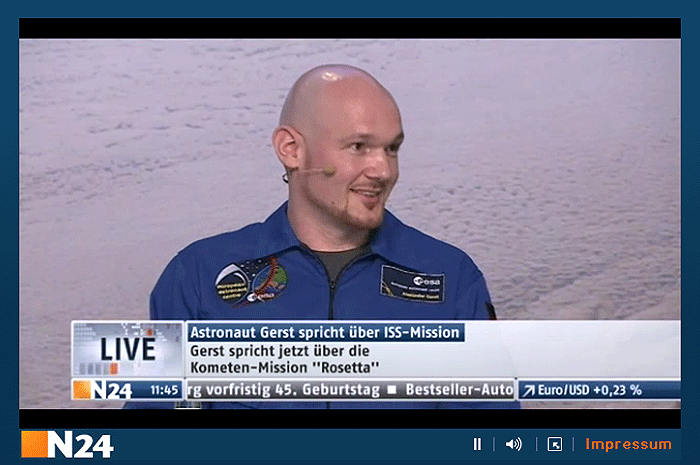

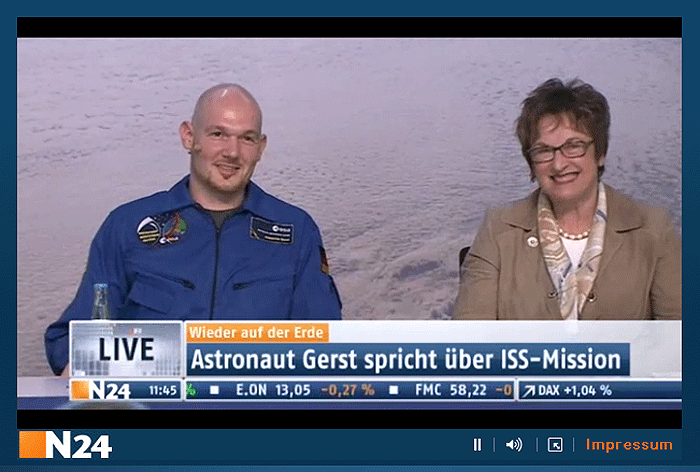
Quelle: Frams N24
5625 Views
